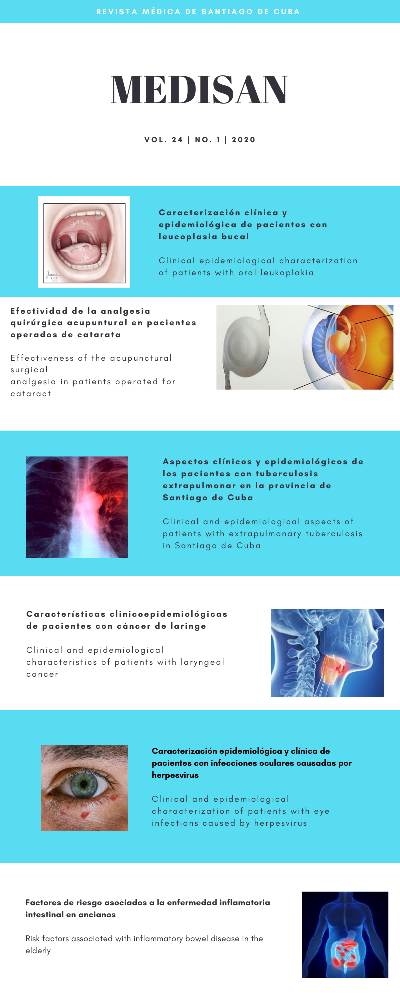Clinical epidemiological characteristics of patients with larynx cancer
Keywords:
laryngeal neoplasms, dysphonia, glottis, cancer institutions.Abstract
Introduction: The larynx is the most common localization of non cutaneous head and neck malignancies.
Objective: To characterize those affected patients due to larynx malignancies.
Methods: A descriptive, cross-sectional and retrospective study of 242 patients with larynx carcinoma was carried out, they were assisted in Conrado Benítez García Provincial Teaching Cancer Hospital in Santiago de Cuba, from January, 2013 to December, 2015.
Results: Most of the patients were men (88.8 %), with an 8:1 ratio regarding the female sex, and mean age was of 65 years. Likewise, nicotine addiction was present in 204 patients (84.3 %) and glottic tumors were the most frequent, with 168 affected, of which 89.3% presented dysphonia as first symptom, followed in order by the increase of cervical volume as main manifestation of the supraglottis (26.6 %) and subglottis (60.0 %) cancer. The predominant stage at the moment of the diagnosis was the I (35.5 %).
Conclusions: At the present time larynx malignancies are an important health problem for the upward tendency in the number of patients worldwide.
Downloads
References
2. Siegel RL, Miller KD, Jemal A. Cancer statistics, 2016. CA Cancer J Clin. 2016;66(1):7-30.
3. Howlader N, Noone AM, Krapcho M, Miller D, Brest A, Yu M, et al. SEER Cancer Statistics Review, 1975-2016. Bethesda: National Cancer Institute; 2018 [citado 05/02/2019]. Disponible en: https://seer.cancer.gov/csr/1975_2016/
4. Cuba. Ministerio de Salud Pública; Dirección de Registros Médicos y Estadísticas de Salud. Anuario estadístico de salud 2015. La Habana: MINSAP; 2016 [citado 05/02/2019]. Disponible en: http://files.sld.cu/dne/files/2016/04/Anuario_2015_electronico-1.pdf
5. Steuer CE, El-Deiry M, Parks JR, Higgins KA, Saba NF. An update on larynx cancer. CA Cancer J Clin. 2017;67(1):31-50.
6. Bradley PJ. Laryngeal cancer in nondrinker nonsmoker young patients: a distinct pathological entity? Curr Opin Otolaryngol Head Neck Surg. 2016;24(2):140-7.
7. Shin JY, Truong MT. Racial disparities in laryngeal cancer treatment and outcome: A population‐based analysis of 24,069 patients. Laryngoscope. 2015;125(7):1667–74.
8. Villamizar J, Chacón J. Sobrevida en pacientes con cáncer de laringe. Atendidos en un hospital de tercer nivel. Manizales 1986-1998. Acta Otorrinolaringol Cir Cabeza Cuello. 2002 [citado 05/02/2019];30(4):155-9. Disponible en: http://encolombia.com/medicina/revistas-medicas/aoccc/vol-304/otorrino30402-sobrevida/
9. Ledo de la Luz AA, Alfonso Muñoz E. Caracterización clínica y epidemiológica de pacientes con cáncer laríngeo. Rev Cub Med Mil. 2018;47(3):276-83.
Published
How to Cite
Issue
Section
License
All the articles can be downloaded or read for free. The journal does not charge any amount of money to the authors for the reception, edition or the publication of the articles, making the whole process completely free. Medisan has no embargo period and it is published under the license of Creative Commons, International Non Commercial Recognition 4.0, which authorizes the copy, reproduction and the total or partial distribution of the articles in any format or platform, with the conditions of citing the source of information and not to be used for profitable purposes.





